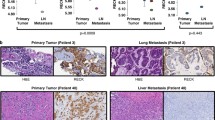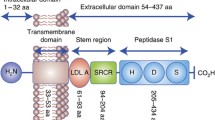Abstract
The RECK (reversion-inducing cysteine rich protein with Kazal motifs) protein was initially discovered by its ability to induce reversion in ras-activated fibroblasts. The key action of RECK is to inhibit matrix metalloproteinases (MMPs) involved in breakdown of the extracellular matrix (ECM), and angiogenesis—namely MMP-2, MMP-9 and MTP-1. To this effect, it plays important physiological roles in embryogenesis and vasculogenesis. Additionally, it has a significant effect on tumorigenesis by limiting angiogenesis and invasion of tumours through the ECM. RECK has been studied in the context of a number of human tumours including colorectal, breast, pancreas, gastric, hepatocellular, prostate, and non-small cell lung carcinoma. In many of these tumours, RECK is down-regulated most likely as a result of inhibition at the Sp1 promoter site. MMP-2 and MMP-9 generally show an inverse association with RECK expression, but there are exceptions to this rule. Likewise, a reduction in tumour microvascular density (MVD) and VEGF have also been correlated with increased RECK levels, although more studies are required to define this effect. The predominant finding across all human tumour studies is a significantly improved prognosis (due to decreased invasion and metastasis) in tumours with preserved RECK expression. Although further research is required, RECK is a promising prognostic marker and potential therapeutic agent in multiple cancers.
Similar content being viewed by others
References
Oh, J., Takahashi, R., Kondo, S., Mizoguchi, A., Adachi, E., & Sasahara, R. M., et al. (2001). The membrane-anchored MMP inhibitor RECK is a key regulator of extracellular matrix integrity and angiogenesis. Cell, 107, 789–00.
Takahashi, C., Sheng, Z., Horan, T. P., Kitayama, H., Maki, M., & Hitomi, K., et al. (1998). Regulation of matrix metalloproteinase-9 and inhibition of tumor invasion by the membrane-anchored glycoprotein RECK. Proceedings of the National Academy of Sciences of the United States of America, 95, 13221–3226.
Eisenberg, I., Hochner, H., Sadeh, M., Argov, Z., & Mitrani-Rosenbaum, S. (2002). Establishment of the genomic structure and identification of thirteen single-nucleotide polymorphisms in the human RECK gene. Cytogenetic and Genome Research, 97, 58–1.
Kim, S. K., Ro, J. Y., Kemp, B. L., Lee, J. S., Kwon, T. J., & Fong, K. M., et al. (1997). Identification of three distinct tumor suppressor loci on the short arm of chromosome 9 in small cell lung cancer. Cancer Research, 57, 400–03.
Carpenter, G., & Cohen, S. (1990). Epidermal growth factor. Journal of Biological Chemistry, 265(14), 7709–712.
Rawlings, N. D., Tolle, D. P., & Barrett, A. J. (2004). Evolutionary families of peptidase inhibitors. Biochemical Journal, 378, 705–16.
Noel, A., Maillard, C., Rocks, N., Jost, M., Chabottaux, V., & Sounni, N. E., et al. (2004). Membrane associated proteases and their inhibitors in tumour angiogenesis. Journal of Clinical Pathology, 57(6), 577–84.
Müller, G., Jung, C., Frick, W., Bandlow, W., & Kramer, W. (2002). Interaction of phosphatidylinositolglycan(-peptides) with plasma membrane lipid rafts triggers insulin-mimetic signaling in rat adipocytes. Archives of Biochemistry and Biophysics, 408(1), 7–6.
Fisher, J. F., & Mobashery, S. (2006). Recent advances in MMP inhibitor design. Cancer and Metastasis Reviews, 25(1), 115–36.
Takeuchi, T., Hisanaga, M., Nagao, M., Ikeda, N., Fujii, H., & Koyama, F., et al. (2004). The membrane-anchored matrix metalloproteinase (MMP) regulator RECK in combination with MMP-9 serves as an informative prognostic indicator for colorectal cancer. Clinical Cancer Research, 10(16), 5572–579.
Takenaka, K., Ishikawa, S., Kawano, Y., Yanagihara, K., Miyahara, R., & Otake, Y., et al. (2004). Expression of a novel matrix metalloproteinase regulator, RECK, and its clinical significance in resected non-small cell lung cancer. European Journal of Cancer, 40(10), 1617–623.
Takenaka, K., Ishikawa, S., Yanagihara, K., Miyahara, R., Hasegawa, S., & Otake, Y., et al. (2005). Prognostic significance of reversion-inducing cysteine-rich protein with Kazal motifs expression in resected pathologic stage IIIA N2 non-small-cell lung cancer. Annals of Surgical Oncology, 12(10), 817–24.
Simizu, S., Takagi, S., Tamura, Y., & Osada, H. (2005). RECK-mediated suppression of tumor cell invasion is regulated by glycosylation in human tumor cell lines. Cancer Research, 65(16), 7455–461.
Sasahara, R. M., Takahashi, C., & Noda, M. (1999). Involvement of the Sp1 site in ras-mediated downregulation of the RECK metastasis suppressor gene. Biochemical and Biophysical Research Communications, 264(3), 668–75.
Sasahara, R. M., Brochado, S. M., Takahashi, C., Oh, J., Maria-Engler, S. S., & Granjeiro, J. M., et al. (2002). Transcriptional control of the RECK metastasis/angiogenesis suppressor gene. Cancer Detection and Prevention, 26(6), 435–43.
Lou, Z., O’Reilly, S., Liang, H., Maher, V. M., Sleight, S. D., & McCormick, J. J. (2005). Down-regulation of overexpressed sp1 protein in human fibrosarcoma cell lines inhibits tumor formation. Cancer Research, 65(3), 1007–017.
Kanai, M., Wei, D., Li, Q., Jia, Z., Ajani, J., & Le, X., et al. (2006). Loss of Krüppel-like factor 4 expression contributes to Sp1 overexpression and human gastric cancer development and progression. Clinical Cancer Research, 12(21), 6395–402.
Liu, L. T., Chang, H. C., Chiang, L. C., & Hung, W. C. (2003). Histone deacetylase inhibitor up-regulates RECK to inhibit MMP-2 activation and cancer cell invasion. Cancer Research, 63(12), 3069–072.
Chang, H. C., Liu, L. T., & Hung, W. C. (2004). Involvement of histone deacetylation in ras-induced down-regulation of the metastasis suppressor RECK. Cellular Signalling, 16(6), 675–79.
Liu, L. T., Peng, J. P., Chang, H. C., & Hung, W. C. (2003). RECK is a target of Epstein’Barr virus latent membrane protein 1. Oncogene, 22(51), 8263–270.
Hsu, M. C., Chang, H. C., & Hung, W. C. (2006). HER-2/neu represses the metastasis suppressor RECK via ERK and Sp transcription factors to promote cell invasion. Journal of Biological Chemistry, 281(8), 4718–725.
Furumoto, K., Arii, S., Mori, A., Furuyama, H., Gorrin Rivas, M. J., & Nakao, T., et al. (2001). RECK gene expression in hepatocellular carcinoma: Correlation with invasion-related clinicopathological factors and its clinical significance. Reverse-inducing-cysteine-rich protein with Kazal motifs. Hepatology, 33(1), 189–95.
van der Jagt, M. F., Sweep, F. C., Waas, E. T., Hendriks, T., Ruers, T. J., & Merry, A. H., et al. (2006). Correlation of reversion-inducing cysteine-rich protein with kazal motifs (RECK) and extracellular matrix metalloproteinase inducer (EMMPRIN), with MMP-2, MMP-9, and survival in colorectal cancer. Cancer Letters, 237(2), 289–97.
Span, P. N., Sweep, C. G., Manders, P., Beex, L. V., Leppert, D., & Lindberg, R. L. (2003). Matrix metalloproteinase inhibitor reversion-inducing cysteine-rich protein with Kazal motifs: A prognostic marker for good clinical outcome in human breast carcinoma. Cancer, 97(11), 2710–715.
Riddick, A. C., Shukla, C. J., Pennington, C. J., Bass, R., Nuttall, R. K., & Hogan, A., et al. (2005). Identification of degradome components associated with prostate cancer progression by expression analysis of human prostatic tissues. British Journal of Cancer, 92(12), 2171–180.
Brehmer, B., Biesterfeld, S., & Jakse, G. (2003). Expression of matrix metalloproteinases (MMP-2 and -9) and their inhibitors (TIMP-1 and -2) in prostate cancer tissue. Prostate Cancer and Prostatic Diseases, 6(3), 217–22.
Masui, T., Doi, R., Koshiba, T., Fujimoto, K., Tsuji, S., & Nakajima, S., et al. (2003). RECK expression in pancreatic cancer: Its correlation with lower invasiveness and better prognosis. Clinical Cancer Research, 9(5), 1779–784.
Song, S. Y., Son, H. J., Nam, E., Rhee, J. C., & Park, C. (2006). Expression of reversion-inducing-cysteine-rich protein with Kazal motifs (RECK) as a prognostic indicator in gastric cancer. European Journal of Cancer, 42(1), 101–08.
Kang, H. G., Kim, H. S., Kim, K. J., Oh, J. H., Lee, M. R., & Seol, S. M., et al. (2007). RECK expression in osteosarcoma: Correlation with matrix metalloproteinases activation and tumor invasiveness. Journal of Orthopaedic Research, 25, 696–02.
van Lent, P. L., Span, P. N., Sloetjes, A. W., Radstake, T. R., van Lieshout, A. W., & Heuvel, J. J., et al. (2005). Expression and localisation of the new metalloproteinase inhibitor RECK (reversion inducing cysteine-rich protein with Kazal motifs) in inflamed synovial membranes of patients with rheumatoid arthritis. Annals of the Rheumatic Diseases, 64(3), 368–74.
Dass, C. R., & Choong, P. F. (2006). Biophysical delivery of peptides: Applicability for cancer therapy. Peptides, 27(12), 3479–488.
Dass, C. R., & Choong, P. F. (2006). Carrier-mediated delivery of peptidic drugs for cancer therapy. Peptides, 27(11), 3020–028.
Ek, E. T., Dass, C. R., & Choong, P. F. (2006). Pigment epithelium-derived factor: A multimodal tumor inhibitor. Molecular Cancer Therapeutics, 5(7), 1641–646.
Williams, D. A., & Baum, C. (2003). Medicine. Gene therapy—New challenges ahead. Science, 302(5644), 400–01.
Dass, C. R., Walker, T. L., & Burton, M. A. (2002). Liposomes containing cationic dimethyl dioctadecyl ammonium bromide: Formulation, quality control, and lipofection efficiency. Drug Delivery, 9(1), 11–8.
Dass, C. R., Walker, T. L., Kalle, W. H., & Burton, M. A. (2000). A microsphere’liposome (microplex) vector for targeted gene therapy of cancer. II. In vivo biodistribution study in a solid tumor model. Drug Delivery, 7(1), 15–9.
Dass, C. R., & Burton, M. A. (2003). Modified microplex vector enhances transfection of cells in culture while maintaining tumour-selective gene delivery in-vivo. Journal of Pharmacy and Pharmacology, 55(1), 19–5.
Dass, C. R. (2004). Cyclodextrins and oligonucleotide delivery to solid tumours. Journal of Drug Targeting, 12(1), 1–.
Dass, C. R., Contreras, K. G., Dunstan, D. E., & Choong, P. F. (2007). Chitosan microparticles encapsulating PEDF plasmid demonstrate efficacy in an orthotopic metastatic model of osteosarcoma. Biomaterials, 28, 3026–033.
Liu, L. T., Chang, H. C., Chiang, L. C., & Hung, W. C. (2002). Induction of RECK by nonsteroidal anti-inflammatory drugs in lung cancer cells. Oncogene, 21(54), 8347–350.
Llovet, J. M., Burroughs, A., & Bruix, J. (2003). Hepatocellular carcinoma. Lancet, 362(9399), 1907–917.
Stojadinovic, A., Brooks, A., Hoos, A., Jaques, D. P., Conlon, K. C., & Brennan, M. F. (2003). An evidence-based approach to the surgical management of resectable pancreatic adenocarcinoma. Journal of the American College of Surgeons, 196(6), 954–64.
Author information
Authors and Affiliations
Corresponding author
Rights and permissions
About this article
Cite this article
Clark, J.C.M., Thomas, D.M., Choong, P.F.M. et al. RECK—a newly discovered inhibitor of metastasis with prognostic significance in multiple forms of cancer. Cancer Metastasis Rev 26, 675–683 (2007). https://doi.org/10.1007/s10555-007-9093-8
Published:
Issue Date:
DOI: https://doi.org/10.1007/s10555-007-9093-8




